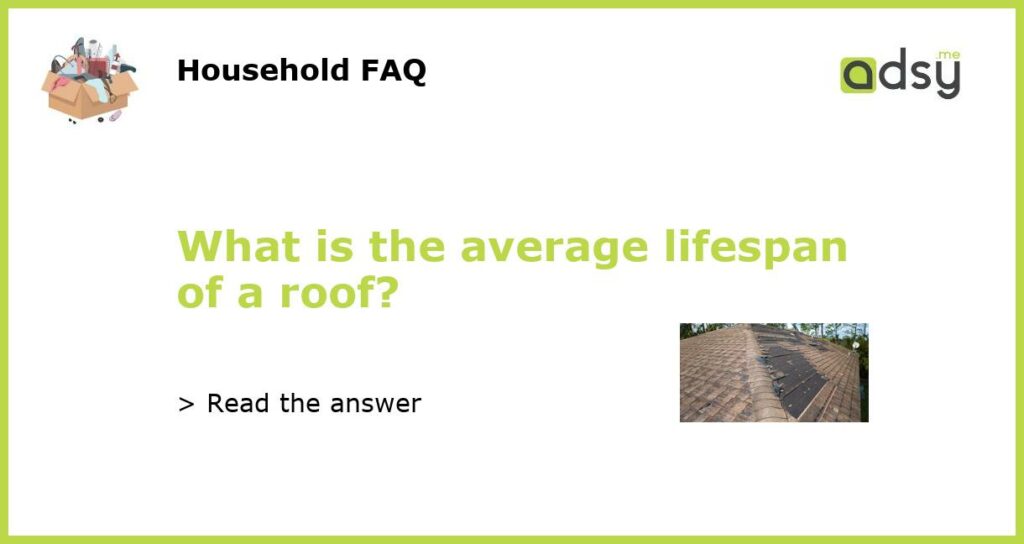Understanding the Lifespan of a Roof
A roof is one of the most critical components of a building, protecting it from the elements and ensuring the safety and comfort of those inside. However, like any other part of a structure, a roof has a limited lifespan. Understanding the average lifespan of a roof can help homeowners and building owners plan for necessary maintenance and replacements, ultimately saving them time and money.
Factors That Influence Roof Lifespan
The lifespan of a roof can vary depending on several factors. These factors include:
1. Roofing Material: Different roofing materials have varying lifespans. For example, asphalt shingles typically last between 20 to 30 years, while metal roofs can last over 50 years. Clay tiles and slate roofs are known for their durability and can last for several decades.
2. Quality of Installation: Proper installation is crucial to the longevity of a roof. A poorly installed roof can lead to leaks, premature deterioration, and ultimately, a shorter lifespan. Hiring a reputable and experienced roofing contractor is key to ensuring a quality installation.
3. Climate and Weather Conditions: The climate and weather patterns in a particular region can significantly impact the lifespan of a roof. Constant exposure to harsh sunlight, heavy rain, snow, or extreme temperature fluctuations can accelerate the aging process of roofing materials.
4. Roof Maintenance: Regular roof maintenance, such as inspecting for damage and addressing minor issues promptly, can help extend its lifespan. Proper maintenance practices include cleaning gutters, removing debris, and ensuring adequate ventilation.
5. Proper Ventilation: Adequate ventilation is essential for a healthy roof. Proper airflow helps prevent moisture buildup and reduces the risk of premature deterioration. A well-ventilated roof can last longer than one with poor ventilation.
The Average Lifespan of Different Roofing Materials
While the lifespan of a roof depends on various factors, here are the average lifespans of some common roofing materials:
1. Asphalt Shingles: Asphalt shingles are the most popular roofing material in North America due to their affordability. The average lifespan of asphalt shingles is around 20 to 30 years.
2. Metal Roofs: Metal roofs are known for their longevity and durability. Depending on the type of metal used, metal roofs can last between 40 to over 70 years.
3. Clay Tiles: Clay tiles are a durable and aesthetically pleasing roofing option. They can last anywhere from 50 to 100 years with proper maintenance.
4. Slate Roofs: Slate roofs are the longest-lasting roofing material available. They can last well over 100 years if properly installed and maintained.
5. Wood Shakes: Wood shakes offer a natural and rustic appearance to a roof. With regular maintenance, they can last between 20 to 40 years.
Signs of an Aging Roof
To determine if a roof is nearing the end of its lifespan, homeowners and building owners should be aware of the following signs:
1. Curling or Buckling Shingles: Asphalt shingles that are curling or buckling are a clear indication of an aging roof. This problem often occurs due to the effects of moisture and sun exposure.
2. Missing or Damaged Shingles: Missing or broken shingles can leave the underlying roof structure vulnerable to water damage and deterioration.
3. Leaks or Water Stains: Water stains on ceilings or walls and leaks during rainfall are evident signs of a roof in need of repair or replacement.
4. Excessive Granule Loss: If asphalt shingles appear to have bald spots or there is an accumulation of granules in gutters or downspouts, it may indicate that the shingles are nearing the end of their lifespan.
5. Sagging Roof: A sagging roof is a severe structural issue that can indicate water damage and compromised roofing materials.
Extending the Lifespan of a Roof
While the lifespan of a roof is ultimately determined by its materials and external factors, homeowners and building owners can take proactive measures to help extend its lifespan:
1. Regular Roof Inspections: Schedule professional roof inspections at least once a year to identify and address any potential issues before they become major problems.
2. Prompt Repairs: Address any signs of damage or leaks promptly to prevent further deterioration of roofing materials.
3. Keep Gutters Clean: Regularly clean and maintain gutters to ensure proper drainage and prevent water buildup near the roof.
4. Trim Surrounding Trees: Overhanging tree branches can damage a roof during storms. Keep trees trimmed to prevent them from rubbing against the roof surface.
5. Ensure Proper Attic Ventilation: Proper attic ventilation helps regulate temperature and moisture levels, reducing the risk of ice dams and premature roof deterioration.
By understanding the average lifespan of different roofing materials and implementing proper maintenance practices, homeowners and building owners can maximize the lifespan and performance of their roofs, ultimately protecting their investment.

